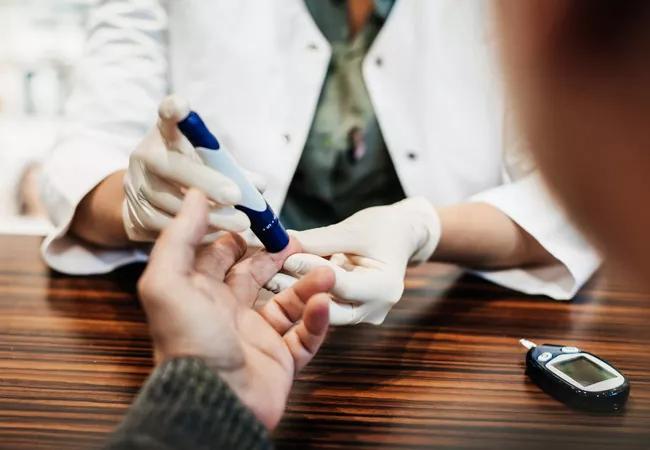Advertisement
Tools to aid in diagnosis, complication management and lifestyle interventions

Outside of healthcare, predictive tools and machine learning (ML) have many applications including financial modeling, sales forecasting, market analysis, fraud detection, recommendations on Amazon and Netflix, and the detection of spam in email. There are many uses for predictive modeling in healthcare, including in population health to identify patients at elevated risk for developing chronic conditions, such as diabetes or heart disease. Innovations, such as computer vision, allow ML systems to “read” and make inferences from digital images and are currently being tested in radiology, pathology and dermatology. With new applications every day, ML an aid in the diagnosis and management of diabetes as well.
Advertisement
Cleveland Clinic is a non-profit academic medical center. Advertising on our site helps support our mission. We do not endorse non-Cleveland Clinic products or services. Policy
Using statistical modeling, Cleveland Clinic researchers have developed a risk calculator to predict episodes of hypoglycemia. Developed by a group of Cleveland Clinic physicians and data scientists, the tool is designed to be used at the point of care with the goal of preventing severe hypoglycemic events after routine outpatient visits.
“In prediction modeling, we take as many characteristics as we can that we know about patients, take all those into account, and based on that do the best job we can in predicting what’s going to happen to patients with each treatment,” says Michael Kattan, MBA, PhD, Chair of Cleveland Clinic’s Department of Quantitative Health Sciences, who led the group of healthcare statistical specialists that developed the prediction tool.
The model is designed for use in a subset of patients with Type 2 diabetes, who experienced a nonsevere hypoglycemic event and for whom that nonsevere event was coded by a clinician. The model also includes data variables such as age, gender, race, median income by zip code, Charlson comorbidity index, HbA1c, body mass index, diabetes medication classes, comorbidities (e.g., cardiovascular disease, congestive heart failure, depression, other psychiatric disorders, dementia, cognitive impairment, chronic kidney disease and alcohol or substance abuse), months since first nonsevere hypoglycemic event and history of nonsevere hypoglycemia within three months.
“We know that severe hypoglycemia is very serious, and seems to be associated with increased cardiovascular risk and death, so prevention is really important,” says Anita Misra-Hebert, MD, MPH, an internist and researcher at Cleveland Clinic who helped design the prediction tool. For our purposes, episodes of severe hypoglycemia are those that require assistance, which we capture in our medical record as those patients who have to go to the emergency room or are hospitalized for an episode of severe hypoglycemia.”
Advertisement
Although a risk factor of more severe events, not all episodes of nonsevere hypoglycemia are reported to or coded by clinicians, according to Dr. Misra-Hebert. “There are people who will have episodes at home, where they realize their blood sugar is low and they eat something and feel better. Sometimes patients present at a routine follow-up visit and report a previous nonsevere event; however, the provider may not think the event is significant enough to put a diagnosis code in the medical record. For this project, the diagnosis code had to be entered by a provider, so we were not able to capture all nonsevere episodes.”
One goal of this work is to raise awareness of the fact that these nonsevere episodes are risk factors for disease, says Dr. Misra-Hebert. “Eventually, we’d like to create a clinical decision support tool that alerts providers if their patient has had a non-severe hypoglycemic event, and then when they are alerted, directs them to this risk calculator. Our electronic medical record does not currently have a way to alert physicians of any previous non-severe hypoglycemic episode, but that’s something we’d like to work on. That said, if physicians are already aware that an episode has occurred, they can plug the variables into this risk calculator to determine future risk of severe hypoglycemia.
If the calculator indicates a high level of risk, medication adjustments and lifestyle interventions may help prevent severe episodes. “I think many providers use clinical judgment, which works well for the most part, but tools like this aid clinical decision making with more quantitative information,” Dr. Misra-Hebert notes.
“The development of risk prediction calculators like this is vital for improving medical decision-making. We’ve developed other tools for predicting risk related to type 2 diabetes, including a calculator that predicts the 10-year risk of major adverse cardiovascular events with and without weight loss surgery, as well as tools to predict late relapse following early postoperative diabetes remission. Tools like these represent further steps toward personalized medicine that will ultimately improve efficiency, outcomes and patient care,” concludes Dr. Kattan.
Advertisement
ML techniques have been used to predict the onset of diabetes in high-risk populations. For example, in the 1980s, researches developed a model to predict diabetes onset among the Pima Indians using data from the National Institute of Diabetes and Digestive and Kidney Diseases. Since then, many other studies have been published that highlight the use of ML in diabetes.
“There are essentially three categories of ML applications right now in diabetes management: ML can be used as a diagnostic tool to help identify patients with prediabetes and diabetes; to aid in its management, as seen with automated insulin delivery systems; and in customizing meal and lifestyle recommendations,” says Kevin Pantalone, DO, an endocrinologist with the Cleveland Clinic Department of Endocrinology, Diabetes and Metabolism.
The speed of innovation has led to a disconnect between developers, regulatory bodies, clinicians and their patients. “Technology moves at such a fast pace that it’s difficult for regulatory bodies to keep up. Patients are not waiting for the next discovery or device that makes life better for them. They are getting creative, and have begun developing their own technology,” says Dr. Broome.
Patients developed a Do-It-Yourself Pancreas System and have standardized the approach to utilizing old insulin pump technology and widely available software to create closed-loop systems. One such movement is the OpenAPS (Open Artificial Pancreas) movement. The individualized system can predict blood glucose trends, and adjust insulin levels based on predictive analytics. The experience of using this device was published before the FDA approved the first commercially available closed loop insulin delivery system.
Advertisement
“[In reference to OpenAPS,] tech savvy individuals in the community are developing their own individualized systems when industry is not able to approve the technology that patients seek,” Dr. Broome continues. “In response to that, the FDA did something somewhat unique — they created offsite regulatory bodies that work with companies to push their limits in creating and approving some of these new technologies at a faster pace.”
Closed loop systems offer a much higher level of glycemic control with fewer hypoglycemic events. However, there are a few roadblocks to the adoption of these new technologies, including the potentially high cost to patients, issues with access, the possible need for patients to upgrade their software and learn a new system with greater frequency.
“Given the rate that we’re developing these systems, patients are being required to update their systems much more frequently than maybe they had in the past. With these breakthroughs, we’ve seen some patients need to update their pumps on almost an annual or biannual basis. It’s asking a lot to have patients upgrade their system and knowledge base this frequently. Some patients are really engaged, while others may be a little more resistant to change in those scenarios. Some companies are offering software updates to current insulin pumps/systems to try to make it easier on patients. I think this will be a trend moving toward — we’ll update systems rather than introducing a brand new system,” says Dr. Broome.
Advertisement
Advertisement

Large-scale joint study links elevated TMAO blood levels and chronic kidney disease risk over time

Investigators are developing a deep learning model to predict health outcomes in ICUs.

International collaboration is most genetically diverse study of the disease to date

Preclinical work promises large-scale data with minimal bias to inform development of clinical tests

Cleveland Clinic researchers pursue answers on basic science and clinical fronts

Study suggests sex-specific pathways show potential for sex-specific therapeutic approaches

Cleveland Clinic launches Quantum Innovation Catalyzer Program to help start-up companies access advanced research technology

Research project aims to pinpoint biomarkers that could speed diagnosis